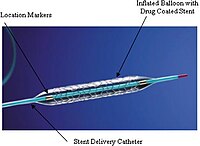
Photo from wikipedia
Background: Cilostazol improves clinical endovascular therapy outcomes for femoropopliteal (FP) lesions in patients with symptomatic peripheral arterial disease, but whether it also has clinical benefits for patients after drug‐eluting stent… Click to show full abstract
Background: Cilostazol improves clinical endovascular therapy outcomes for femoropopliteal (FP) lesions in patients with symptomatic peripheral arterial disease, but whether it also has clinical benefits for patients after drug‐eluting stent implantation remains unclear. Methods: This study is a subanalysis of the ZilvEr PTX for tHe Femoral ArterY and Proximal Popliteal ArteRy (ZEPHYR) study, a prospective multicenter study investigating FP lesions treated with the Zilver (Cook Medical, Bloomington, Ind) paclitaxel‐eluting stent. The present study analyzed 475 lesions in 459 limbs of 399 patients who maintained therapy with aspirin and thienopyridine, with or without cilostazol, during the 1‐year follow‐up period. Results: Restenosis rates at 1 year were assessed with duplex ultrasound imaging (peak systolic velocity ratio >2.4) or angiography (≥50% diameter stenosis) and compared in the groups with and without cilostazol. Propensity score matching was performed to minimize intergroup differences in baseline characteristics. The present study included 93 cilostazol‐treated and 382 cilostazol‐free cases. Among the patients, 71% had diabetes mellitus and 31% were on dialysis. Critical limb ischemia accounted for 29% of cases. The prevalence of de novo lesions was 76%, and in‐stent restenosis was present in 15%. Propensity score matching was performed in 91 pairs. The 1‐year restenosis rate was 33% (95% confidence interval [CI], 23%‐43%) in the cilostazol‐treated group and 51% (95% CI, 41%‐62%) in the cilostazol‐free group (P = .008). The odds ratio was 0.5 (95% CI, 0.3–0.8). Conclusions: The propensity score‐matching analysis demonstrated that additional cilostazol administration was associated with a significantly lower restenosis incidence 1 year after drug‐eluting stent implantation for FP lesions.
Journal Title: Journal of Vascular Surgery
Year Published: 2017
Link to full text (if available)
Share on Social Media: Sign Up to like & get
recommendations!